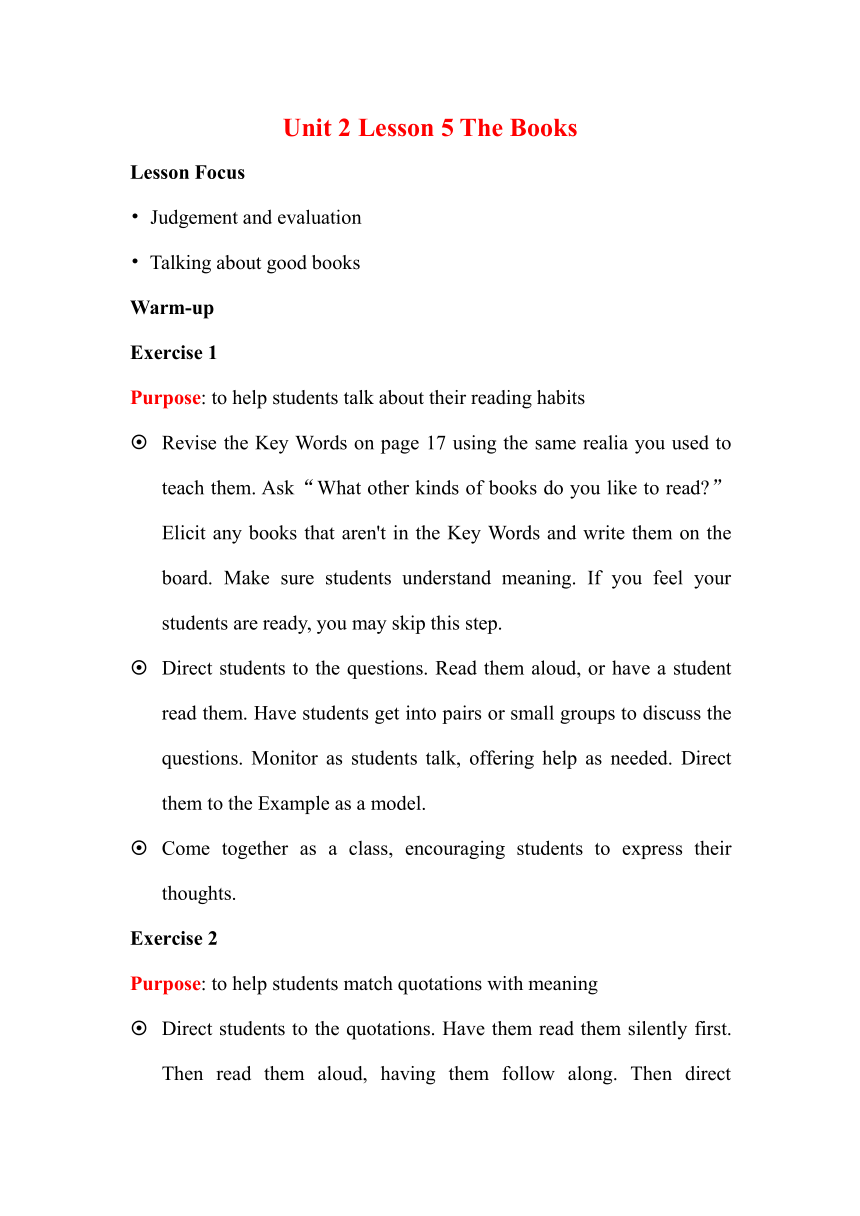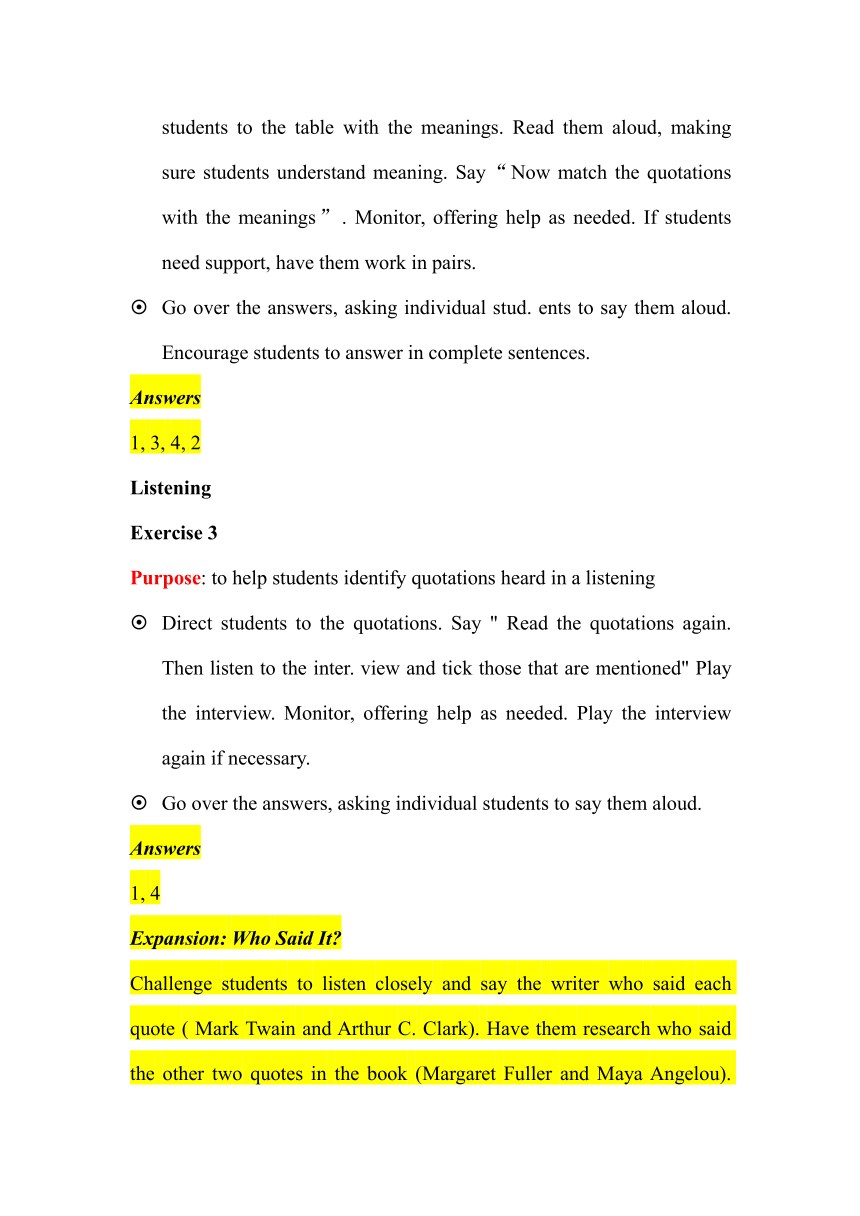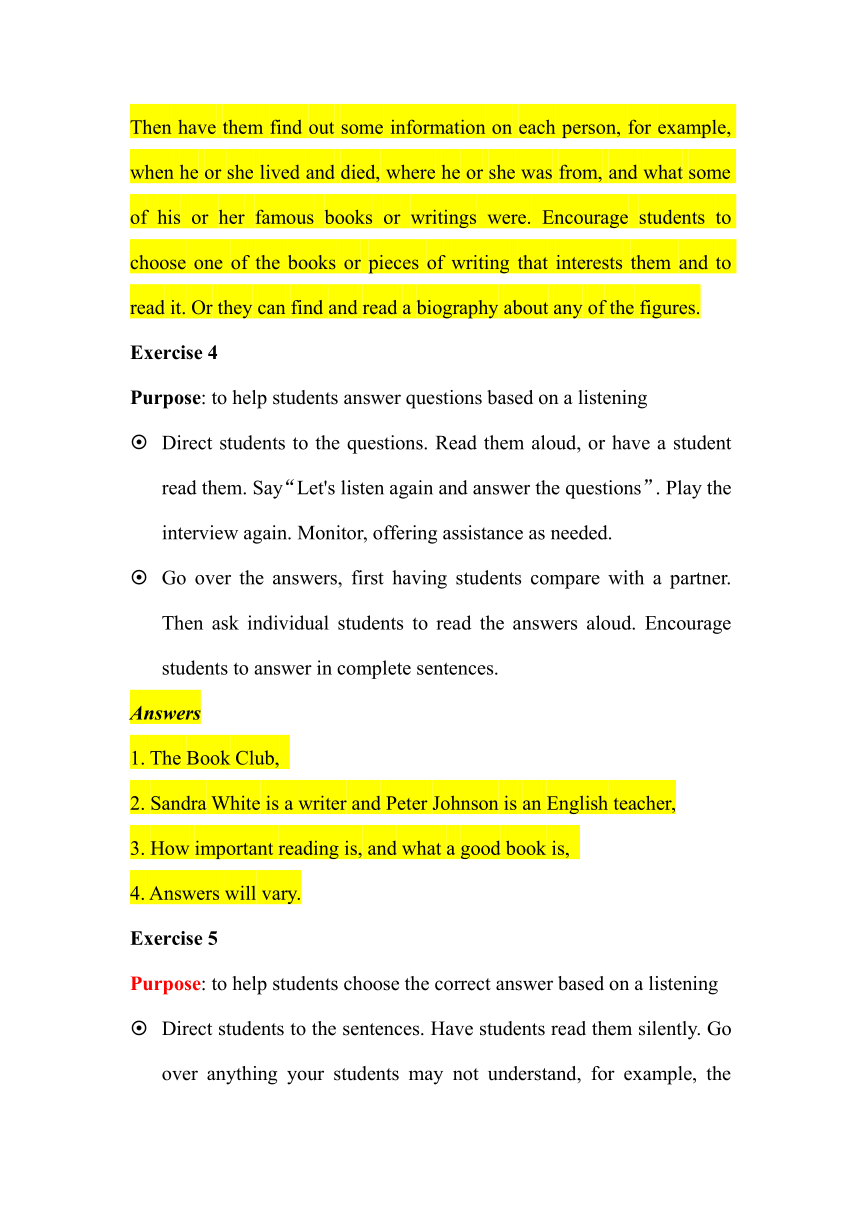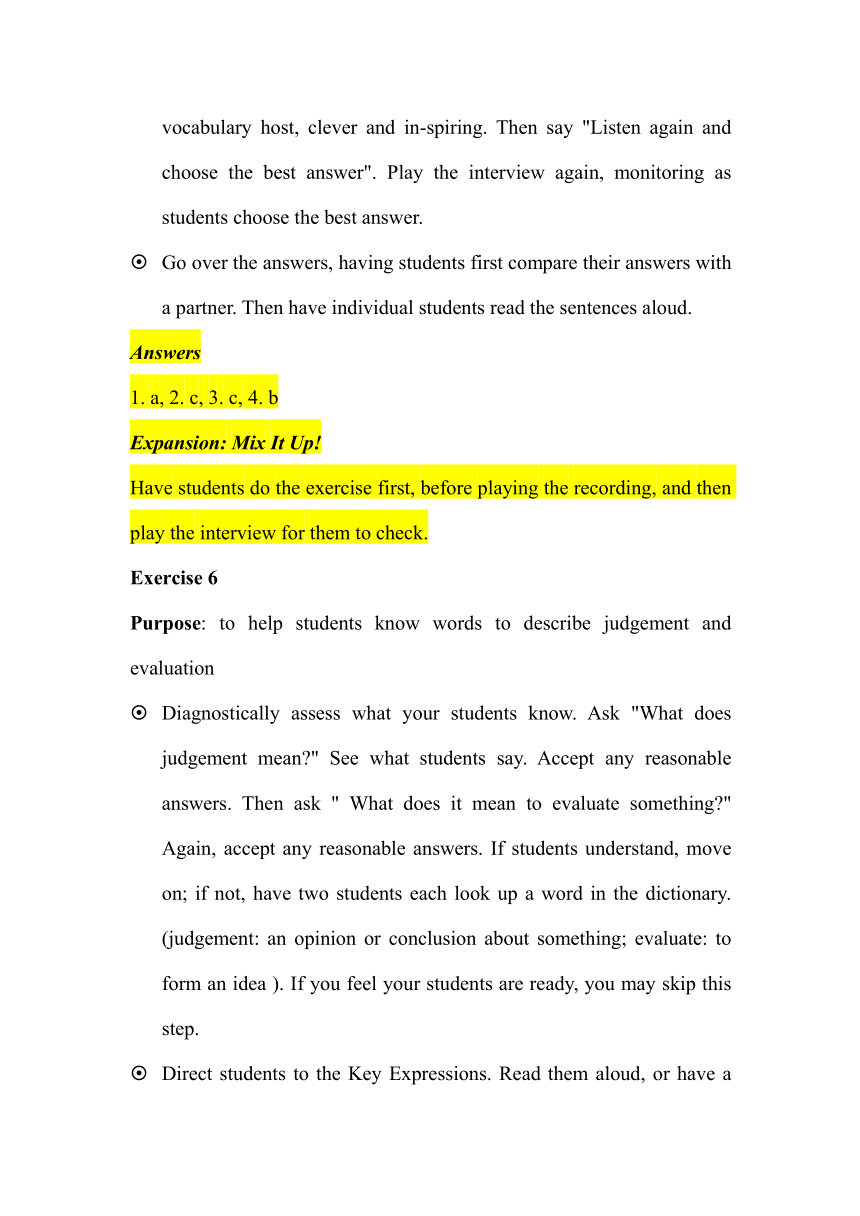Unit 2 Books123.Lesson 5 The Book Club 教学设计2023-2024学年北师大版九年级英语
文档属性
| 名称 | Unit 2 Books123.Lesson 5 The Book Club 教学设计2023-2024学年北师大版九年级英语 |  | |
| 格式 | docx | ||
| 文件大小 | 23.9KB | ||
| 资源类型 | 教案 | ||
| 版本资源 | 北师大版 | ||
| 科目 | 英语 | ||
| 更新时间 | 2023-09-27 21:37:04 | ||
图片预览




文档简介
Unit 2 Lesson 5 The Books
Lesson Focus
Judgement and evaluation
Talking about good books
Warm-up
Exercise 1
Purpose: to help students talk about their reading habits
Revise the Key Words on page 17 using the same realia you used to teach them. Ask“What other kinds of books do you like to read ”Elicit any books that aren't in the Key Words and write them on the board. Make sure students understand meaning. If you feel your students are ready, you may skip this step.
Direct students to the questions. Read them aloud, or have a student read them. Have students get into pairs or small groups to discuss the questions. Monitor as students talk, offering help as needed. Direct them to the Example as a model.
Come together as a class, encouraging students to express their thoughts.
Exercise 2
Purpose: to help students match quotations with meaning
Direct students to the quotations. Have them read them silently first. Then read them aloud, having them follow along. Then direct students to the table with the meanings. Read them aloud, making sure students understand meaning. Say“Now match the quotations with the meanings”. Monitor, offering help as needed. If students need support, have them work in pairs.
Go over the answers, asking individual stud. ents to say them aloud. Encourage students to answer in complete sentences.
Answers
1, 3, 4, 2
Listening
Exercise 3
Purpose: to help students identify quotations heard in a listening
Direct students to the quotations. Say " Read the quotations again. Then listen to the inter. view and tick those that are mentioned" Play the interview. Monitor, offering help as needed. Play the interview again if necessary.
Go over the answers, asking individual students to say them aloud.
Answers
1, 4
Expansion: Who Said It
Challenge students to listen closely and say the writer who said each quote ( Mark Twain and Arthur C. Clark). Have them research who said the other two quotes in the book (Margaret Fuller and Maya Angelou). Then have them find out some information on each person, for example, when he or she lived and died, where he or she was from, and what some of his or her famous books or writings were. Encourage students to choose one of the books or pieces of writing that interests them and to read it. Or they can find and read a biography about any of the figures.
Exercise 4
Purpose: to help students answer questions based on a listening
Direct students to the questions. Read them aloud, or have a student read them. Say“Let's listen again and answer the questions”. Play the interview again. Monitor, offering assistance as needed.
Go over the answers, first having students compare with a partner. Then ask individual students to read the answers aloud. Encourage students to answer in complete sentences.
Answers
1. The Book Club,
2. Sandra White is a writer and Peter Johnson is an English teacher,
3. How important reading is, and what a good book is,
4. Answers will vary.
Exercise 5
Purpose: to help students choose the correct answer based on a listening
Direct students to the sentences. Have students read them silently. Go over anything your students may not understand, for example, the vocabulary host, clever and in-spiring. Then say "Listen again and choose the best answer". Play the interview again, monitoring as students choose the best answer.
Go over the answers, having students first compare their answers with a partner. Then have individual students read the sentences aloud.
Answers
1. а, 2. с, 3. с, 4. b
Expansion: Mix It Up!
Have students do the exercise first, before playing the recording, and then play the interview for them to check.
Exercise 6
Purpose: to help students know words to describe judgement and evaluation
Diagnostically assess what your students know. Ask "What does judgement mean " See what students say. Accept any reasonable answers. Then ask " What does it mean to evaluate something " Again, accept any reasonable answers. If students understand, move on; if not, have two students each look up a word in the dictionary. (judgement: an opinion or conclusion about something; evaluate: to form an idea ). If you feel your students are ready, you may skip this step.
Direct students to the Key Expressions. Read them aloud, or have a student read them. Say“Let's listen to the Key Expressions in context again. Pay attention to the sentences that come before and after the Key Expressions”. Play the interview again. Pause after Peter says, “That's true. Twain was a very wise man”, and ask“What question did the host ask Peter ”Elicit What do you think, Peter Write What do you think on the board. Explain that the first thing one must do to get another's judgement or evaluation on a topic is asking,“What do you think ”Play the recording, stopping after Well, not all books help people learn. Ask " What did Peter say that Susan responded to " Elicit or provide They can all help people learn.
Expansion: Have a Debate!
Note: Use this activity with more proficient students. Teach students more language for evaluating information:
TO AGREE:
Absolutely. / Definitely.
I couldn't agree more.TO DISAGREE:
I see your point, but I don't know.
Well, not in my opinion.
I'm afraid I disagree.
That's not always true.
TO COMPROMISE:
Well, it depends.
I suppose so, but…
Yes, but that's not always the case.
Maybe, but I'm still not so sure.
Then have a debate in class. Think of some“controversial topics,”for example, Should the schoolyear be extended to twelve months Should grades be based solely on exams Should there be an age limit for cellphone use Have students form small groups to discuss these topics, using the new language. Don't worry so much about accuracy; just let students express themselves.
Speaking
Exercise 7
Purpose: to help students express opinions about quotations
Direct students to the quotations on page 20.Ask“What do you think of the quotations Do you agree with them ”Have students get into pairs. Say“Share your opinions with your partner”. Refer students to the Key Expressions and read the Example aloud, if necessary. Monitor, offering help as needed. Check students' pronunciation of the Key Expressions.
Come together as a class. Have a few students share their partners' or their own opinions.
Exercise 8
Purpose: to help students talk about what kinds of books are good books
Ask“What does Sandra say good books are ”Elicit the answer, or if necessary, play the recording beginning with the host's line“How do we know if we're reading a good book or not ”and stop after Sandra says, “Good books are inspiring”. If you feel your students are ready, you may skip this step.
Ask“In your opinion, what kinds of books are good books ”Have students get into pairs and say, “Talk with your partner. Give examples if possible”. Read the Example aloud, it necessary. Monitor as students ask and answer questions, offering help as needed. Refer students to the Key Expressions as they discuss their opinions. Make note of any serious errors and have a feedback session at the end of the activity.
For more practice, have students form new pairs.
Exercise 9
Purpose: to help students express opinions about reading
Have students volunteer to come to the front of the class and share their own opinions. Read the Example aloud, if necessary.
Expansion: Keep Talking !
Note: Use this activity to give students more practice. Write more quotations about reading on the board or on pieces of paper to hang up in the classroom. Have students continue the conversation, making judgements and expressing opinions on the quotations. Here are a few quotations that your students might enjoy talking about:
Either write something worth reading or do something worth writing.
——Benjamin Franklin
If one cannot enjoy reading a book over and over again, there is no point in reading it at all.
——Oscar Wilde
There are worse crimes than burning books.One of them is not reading them.
——Ray Bradbury
The worst thing about new books is they keep us from reading the old ones.
——John Wooden
Encourage your students to learn more about the authors quoted here.
If time allows, do Workbook pages 126 and 127 in class. Alternatively, assign for homework.
Lesson Focus
Judgement and evaluation
Talking about good books
Warm-up
Exercise 1
Purpose: to help students talk about their reading habits
Revise the Key Words on page 17 using the same realia you used to teach them. Ask“What other kinds of books do you like to read ”Elicit any books that aren't in the Key Words and write them on the board. Make sure students understand meaning. If you feel your students are ready, you may skip this step.
Direct students to the questions. Read them aloud, or have a student read them. Have students get into pairs or small groups to discuss the questions. Monitor as students talk, offering help as needed. Direct them to the Example as a model.
Come together as a class, encouraging students to express their thoughts.
Exercise 2
Purpose: to help students match quotations with meaning
Direct students to the quotations. Have them read them silently first. Then read them aloud, having them follow along. Then direct students to the table with the meanings. Read them aloud, making sure students understand meaning. Say“Now match the quotations with the meanings”. Monitor, offering help as needed. If students need support, have them work in pairs.
Go over the answers, asking individual stud. ents to say them aloud. Encourage students to answer in complete sentences.
Answers
1, 3, 4, 2
Listening
Exercise 3
Purpose: to help students identify quotations heard in a listening
Direct students to the quotations. Say " Read the quotations again. Then listen to the inter. view and tick those that are mentioned" Play the interview. Monitor, offering help as needed. Play the interview again if necessary.
Go over the answers, asking individual students to say them aloud.
Answers
1, 4
Expansion: Who Said It
Challenge students to listen closely and say the writer who said each quote ( Mark Twain and Arthur C. Clark). Have them research who said the other two quotes in the book (Margaret Fuller and Maya Angelou). Then have them find out some information on each person, for example, when he or she lived and died, where he or she was from, and what some of his or her famous books or writings were. Encourage students to choose one of the books or pieces of writing that interests them and to read it. Or they can find and read a biography about any of the figures.
Exercise 4
Purpose: to help students answer questions based on a listening
Direct students to the questions. Read them aloud, or have a student read them. Say“Let's listen again and answer the questions”. Play the interview again. Monitor, offering assistance as needed.
Go over the answers, first having students compare with a partner. Then ask individual students to read the answers aloud. Encourage students to answer in complete sentences.
Answers
1. The Book Club,
2. Sandra White is a writer and Peter Johnson is an English teacher,
3. How important reading is, and what a good book is,
4. Answers will vary.
Exercise 5
Purpose: to help students choose the correct answer based on a listening
Direct students to the sentences. Have students read them silently. Go over anything your students may not understand, for example, the vocabulary host, clever and in-spiring. Then say "Listen again and choose the best answer". Play the interview again, monitoring as students choose the best answer.
Go over the answers, having students first compare their answers with a partner. Then have individual students read the sentences aloud.
Answers
1. а, 2. с, 3. с, 4. b
Expansion: Mix It Up!
Have students do the exercise first, before playing the recording, and then play the interview for them to check.
Exercise 6
Purpose: to help students know words to describe judgement and evaluation
Diagnostically assess what your students know. Ask "What does judgement mean " See what students say. Accept any reasonable answers. Then ask " What does it mean to evaluate something " Again, accept any reasonable answers. If students understand, move on; if not, have two students each look up a word in the dictionary. (judgement: an opinion or conclusion about something; evaluate: to form an idea ). If you feel your students are ready, you may skip this step.
Direct students to the Key Expressions. Read them aloud, or have a student read them. Say“Let's listen to the Key Expressions in context again. Pay attention to the sentences that come before and after the Key Expressions”. Play the interview again. Pause after Peter says, “That's true. Twain was a very wise man”, and ask“What question did the host ask Peter ”Elicit What do you think, Peter Write What do you think on the board. Explain that the first thing one must do to get another's judgement or evaluation on a topic is asking,“What do you think ”Play the recording, stopping after Well, not all books help people learn. Ask " What did Peter say that Susan responded to " Elicit or provide They can all help people learn.
Expansion: Have a Debate!
Note: Use this activity with more proficient students. Teach students more language for evaluating information:
TO AGREE:
Absolutely. / Definitely.
I couldn't agree more.TO DISAGREE:
I see your point, but I don't know.
Well, not in my opinion.
I'm afraid I disagree.
That's not always true.
TO COMPROMISE:
Well, it depends.
I suppose so, but…
Yes, but that's not always the case.
Maybe, but I'm still not so sure.
Then have a debate in class. Think of some“controversial topics,”for example, Should the schoolyear be extended to twelve months Should grades be based solely on exams Should there be an age limit for cellphone use Have students form small groups to discuss these topics, using the new language. Don't worry so much about accuracy; just let students express themselves.
Speaking
Exercise 7
Purpose: to help students express opinions about quotations
Direct students to the quotations on page 20.Ask“What do you think of the quotations Do you agree with them ”Have students get into pairs. Say“Share your opinions with your partner”. Refer students to the Key Expressions and read the Example aloud, if necessary. Monitor, offering help as needed. Check students' pronunciation of the Key Expressions.
Come together as a class. Have a few students share their partners' or their own opinions.
Exercise 8
Purpose: to help students talk about what kinds of books are good books
Ask“What does Sandra say good books are ”Elicit the answer, or if necessary, play the recording beginning with the host's line“How do we know if we're reading a good book or not ”and stop after Sandra says, “Good books are inspiring”. If you feel your students are ready, you may skip this step.
Ask“In your opinion, what kinds of books are good books ”Have students get into pairs and say, “Talk with your partner. Give examples if possible”. Read the Example aloud, it necessary. Monitor as students ask and answer questions, offering help as needed. Refer students to the Key Expressions as they discuss their opinions. Make note of any serious errors and have a feedback session at the end of the activity.
For more practice, have students form new pairs.
Exercise 9
Purpose: to help students express opinions about reading
Have students volunteer to come to the front of the class and share their own opinions. Read the Example aloud, if necessary.
Expansion: Keep Talking !
Note: Use this activity to give students more practice. Write more quotations about reading on the board or on pieces of paper to hang up in the classroom. Have students continue the conversation, making judgements and expressing opinions on the quotations. Here are a few quotations that your students might enjoy talking about:
Either write something worth reading or do something worth writing.
——Benjamin Franklin
If one cannot enjoy reading a book over and over again, there is no point in reading it at all.
——Oscar Wilde
There are worse crimes than burning books.One of them is not reading them.
——Ray Bradbury
The worst thing about new books is they keep us from reading the old ones.
——John Wooden
Encourage your students to learn more about the authors quoted here.
If time allows, do Workbook pages 126 and 127 in class. Alternatively, assign for homework.
同课章节目录
- Unit 1 Language
- Lesson 1 Body Language
- Lesson 2 Different Kinds of Language
- Lesson 3 Language Learning Tips
- Communication Workshop
- Unit 2 Books
- Lesson 4 Classics
- Lesson 5 The Book Club
- Lesson 6 Tom Sawye
- Communication Workshop
- Unit 3 Creativity
- Lesson 7 A Famous Invento
- Lesson 8 Good or Bad?
- Lesson 9 Creative Minds
- Communication Workshop
- Unit 4 Space
- Lesson 10 Life in Space
- Lesson 11 The Amazing Shenzhou
- Lesson 12 The Spaceship
- Communication Workshop
- Unit 5 Literature
- Lesson 13 Anne of Green Gables
- Lesson 14 The Dark Room
- Lesson 15 A Famous Write
- Communication Workshop
- Unit 6 Role Models
- Lesson 16 Yao Ming
- Lesson 17 People in Our Lives
- Lesson 18 Steve Jobs
- Communication Workshop
- Unit 7 Journeys
- Lesson 19 The Silk Road
- Lesson 20 Life in a Journey
- Lesson 21 To the South Pole
- Communication Workshop
- Unit 8 Discoveries
- Lesson 22 Famous Discoveries
- Lesson 23 Discovery of the Yea
- Lesson 24 An Experiment Report
- Communication Workshop
- Unit 9 Save the Planet
- Lesson 25 Going Green
- Lesson 26 Our Rive
- Lesson 27 Tree Heroes
- Communication Workshop
